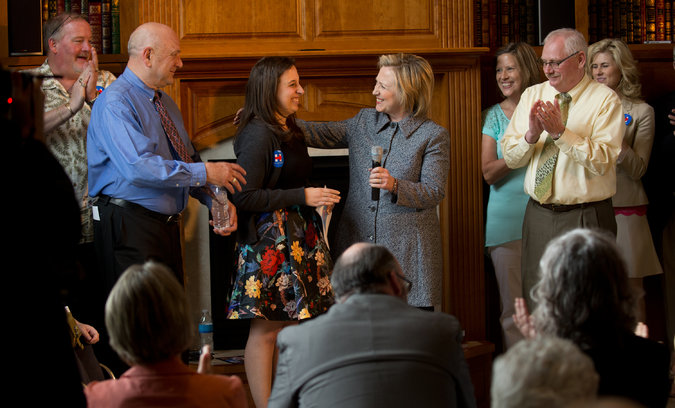Jeb Bush has his famous last name as a calling card, for better or worse. But Scott Walker’s name does not ring many bells outside Wisconsin.

Ted Cruz is not even well known in Texas.
Republican presidential hopefuls will spend millions of dollars trying to get voters to remember their names and something that sets them apart. But the one White House contender who needs no introduction faces a different sort of problem:
Everybody knows Hillary Rodham Clinton.
She did not just co-star in a national soap opera during her husband’s eight-year presidency: She reinvented herself as a senator from the nation’s biggest media market, New York; reintroduced herself again, this time to the nation, as a presidential candidate in 2008 and then remade herself into the country’s chief diplomat.
She never left the stage.
Not since Richard M. Nixon mounted a comeback in 1968, historians and pollsters say, has a candidate entered a presidential contest with so low a bar for name recognition or so high a bar for changing voters’ opinions.
What Hillary Clinton Would Need to Do to Win
Their specific challenges are hardly similar: Nixon needed to recover from a crushing defeat that sent him into the political wilderness. Mrs. Clinton merely needs to rekindle interest in her as a candidate after a short hiatus from politics and a four-year tenure as President Obama’s emissary on the world stage.
But the campaign playbooks of Nixon and Mrs. Clinton seem to share some pages.
Nixon strove to show a more casual side by bypassing journalists and staging town-hall-style events — orchestrated by his media consultant, Roger Ailes — at theaters across the country packed with friendly audiences. Taking softball questions, he kept to his talking points and struck television viewers as more relaxed than the sweaty man they remembered from his debates against John F. Kennedy in 1960.
A lot of people who thought they’d made up their minds about him saw a different version, said Kenneth L. Khachigian, a speechwriter for Nixon and later for Ronald Reagan. That’s a prime example of someone who had a lot of perceived political baggage and who remade himself.
Mrs. Clinton, too, has been ducking reporters and instead holding round-table discussions with carefully chosen voters in early voting states. (Aides say the questions those voters ask are not screened.) She has used the sessions to share lesser-known vignettes from her past: her mother’s impoverished upbringing; her middle-class childhood in Chicago; her work in the 1970s as an advocate for children; her juggling work and child rearing as a young lawyer in Arkansas.
On Tuesday, she will talk to small-business owners in Cedar Falls, Iowa, part of her second swing through the state.
At one event in Las Vegas, she sat with high school students whose parents are undocumented immigrants. It was a canny move: Young people and Latinos are two demographic groups whose opinions Mrs. Clinton may still be able to shape, Democratic pollsters say.
There are not many others.
Only 1 percent of voters have never heard of Mrs. Clinton, a CNN poll found in March (suggesting the network’s pollsters managed to reach a few people living in caves).
A larger number, but still just 11 percent of all voters, said they did not know enough about her to form an opinion, according to a New York Times-CBS poll published this month. By contrast, 43 percent said they did not know enough about Mr. Bush, the best-known Republican contender.
On the bright side for Mrs. Clinton, she enters the race with a devoted base of supporters, mostly women, who appear solidly in her corner. Women in big states like Ohio and Pennsylvania heavily favored Mrs. Clinton in the 2008 Democratic primaries, driving her defeat of Barack Obama in those states.
Mrs. Clinton remains highly popular with African-Americans, college-educated women and single women, said Celinda Lake, a Democratic pollster.
Scott Keeter, director of survey research at the Pew Research Center, said Mrs. Clinton’s profile in the polls was like that of an incumbent facing re-election.
We know from political science that a significant majority of the electorate, upward of 90 percent, know how they’ll vote, he said. You’re talking about 10 to 15 percent of the electorate who are in play, and then you have to factor in enthusiasm and turnout.
The slivers of swing voters Mrs. Clinton’s campaign hopes she can sway include married women in the suburbs. They love her experience, Ms. Lake said, and they like the idea of having a woman president.
The unknownwild card is whether Mrs. Clinton’s chance to make history as the first female president will motivate voters who may be less inclined to support her, Mr. Keeter said.
Similarly, voters under 30 years old were far more likely to be undecided or to say they did not have an opinion of Mrs. Clinton, according to the Times-CBS poll.
Even though she’s so well known, there’s an aspect of a slate that can be written upon, said Jennifer Granholm, the former governor of Michigan who is co-chairwoman of Priorities USA Action, a pro-Clinton super PAC. Young people may need to be reminded about her.
This year’s cozy round-table discussions are not the first time Mrs. Clinton has tried to show voters a softer side. In her 2008 campaign, though, she waited until her favorability ratings had fallen during her heated primary battle with Mr. Obama.
The effort then included warm video testimonials about the Hillary I know from her oldest friends and people she had met as a senator. I thought she was a bit remote, Shannon Mallozzi, a Long Island mother said in one video. She sat with me, and she was just phenomenal. That day, it was two moms sitting in a car.
But the effort seemed to some to be a calculated attempt by a candidate who was behind.
Trying too hard to change voters’ minds about a candidate’s character or life story can be a trap, as Mitt Romney discovered in 2012.
Stung by attacks portraying him as a ruthless corporate titan, his aides tried to change public opinion about Mr. Romney’s years at Bain Capital. Kevin Madden, who was a senior adviser to Mr. Romney, said it was a mistake not to keep focused on communicating the candidate’s forward-looking ideas.
Instead of reintroducing his businessman profile, it should have been, ‘How are we going to tackle the big economic challenges?’ he said.
The 2016 campaign is still in its early days, making this the prime time for the candidates to try to shape what the voters think of them. The later it gets, the harder that can be.
In 2004, the Democratic nominee, John Kerry, who battled an image of being effete, took a well-publicized hunting trip dressed in camouflage, hoping to show he could relate to voters who drive pickup trucks with gun racks.
That was authentic, but perceived as inauthentic, said Mark Mellman, a pollster who advised Mr. Kerry. The truth is, he did actually bag a lot of birds on that trip.
Changing people’s deeply held views, he added, is the hardest thing to do in politics and in life.





